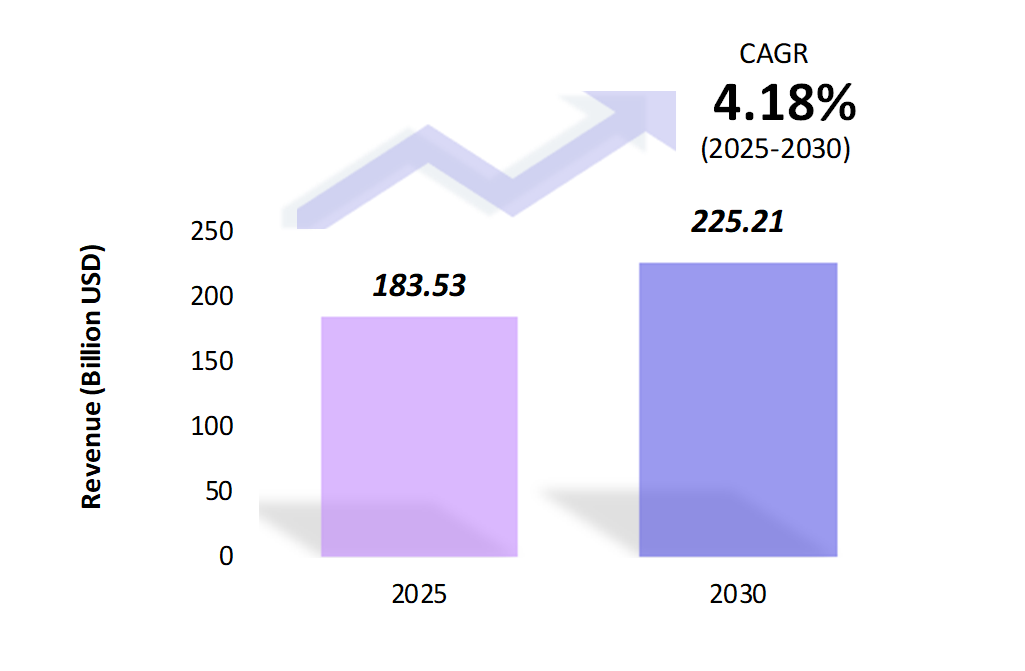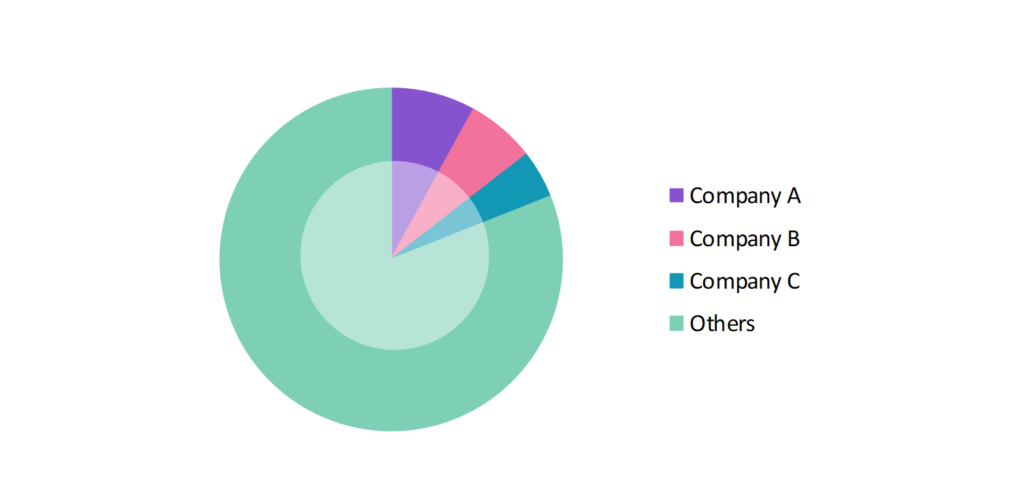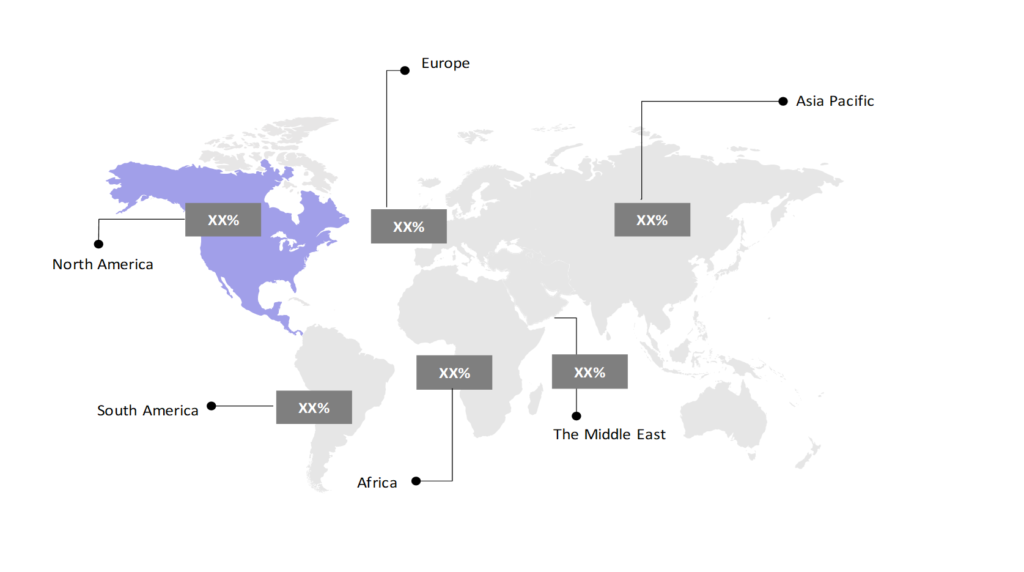Food Container Market Insights: Size, Share, Growth Analysis & Forecast (2024-2029)
The market report provided a comprehensive analysis segmented by Material (Plastic, Metal, Glass, Others); by Product (Bottles & Jars, Cans, Cups & Tubs, Boxes, Others); by Geography (North America, South America, Asia Pacific, Europe, The Middle East, Africa).
Outlook

- The food container market is estimated to be at USD 183.53 Bn in 2025 and is anticipated to reach USD 225.21 Bn in 2030.
- The food container market is registering a CAGR of 4.18% during the forecast period 2025-2030.
- The global food container market includes various packaging solutions for storing and transporting food safely, driven by demand for convenience foods and waste reduction.
Request a free sample.
Ecosystem

- The participants in the global food container industry are driving innovations in sustainable and functional packaging to maintain market leadership.
- These companies focus on innovation in biodegradable packaging as they strive to meet the demand for eco-friendly products, along with mergers and acquisitions, to expand their product portfolio and maintain a competitive edge in the market.
- Several important entities in the food container market include Amcor Group; Silgan Holdings Inc.; Ardagh Group S.A.; Berry Global, Inc.; Sonoco Products Co.; and others.
Ask for customization.
Findings
| Attributes | Values |
|---|---|
| Historical Period | 2019-2023 |
| Base Year | 2024 |
| Forecast Period | 2025-2030 |
| Market Size (2025) | USD 183.53 Bn |
| Market Size (2030) | USD 225.21 Bn |
| Growth Rate | 4.18% CAGR from 2025 to 2030 |
| Key Segments | Material (Plastic, Metal, Glass, Others); Product (Bottles & Jars, Cans, Cups & Tubs, Boxes, Others); Geography (North America, South America, Asia Pacific, Europe, The Middle East, Africa) |
| Key Vendors | Amcor Group; Silgan Holdings Inc.; Ardagh Group S.A.; Berry Global, Inc.; Sonoco Products Co. |
| Key Countries | The US; Canada; Mexico; Brazil; El Salvador; Colombia; China; Vietnam; Japan; South Korea; The UK; Germany; France; Turkey; UAE; Israel; Morocco; South Africa |
| Largest Market | North America |
Get a free quote.
Trends
- Shift to Sustainable Materials: There is an increasing trend toward sustainable food container materials like bioplastics, recyclable glass, and compostable paper-based containers. Consumers are prioritizing eco-friendly packaging to reduce their environmental footprint, and manufacturers are responding by adopting more biodegradable materials.
- Focus on Transparent Packaging: Transparent food containers are gaining popularity as consumers want to see the product before purchase, associating transparency with freshness and quality. This trend is prevalent in fresh produce, dairy, and bakery products, where visual appeal is a purchase driver.
- Smart and Functional Packaging: Smart packaging, including containers with temperature sensors and time indicators, is emerging to ensure food quality and safety. Such packaging helps consumers monitor freshness, especially for perishable items like meat and dairy, and adds value through functionality. In 2022, Thinfilm Electronics developed smart labels for food containers that monitor product freshness, helping reduce food waste.
Speak to analyst.
Catalysts
- Advancements in Food Preservation Technology: Innovations in food preservation technology, such as modified atmosphere packaging (MAP) and vacuum sealing, are driving the demand for food containers. These technologies help maintain food quality, extend shelf life, and reduce spoilage, benefiting manufacturers and consumers. For instance, companies like Amcor have developed high-performance containers using MAP for perishable products, addressing the demand for extended shelf life.
- Increase in Online Grocery and Food Delivery Services: The expansion of online grocery shopping and food delivery services has fueled the demand for durable, tamper-evident, and safe food containers. Packaging that ensures product safety during transport and handling is essential for online food commerce. Companies like Uber Eats and Instacart have partnered with packaging providers to introduce spill-proof, tamper-resistant containers for food deliveries.
- Rising Demand for Packaged and Processed Foods: With increasing urbanization and busy lifestyles, there is a growing demand for packaged and processed foods that offer convenience. This shift has led to a surge in the need for food containers, especially those designed for single-serve and ready-to-eat meals.
Inquire before buying.
Restraints
- Environmental Impact of Plastic Waste: Although plastic is widely used in food packaging due to its durability and low cost, it poses significant environmental challenges. The accumulation of plastic waste has led to stricter regulations and consumer pushback, putting pressure on companies to shift to more sustainable materials.
- Fluctuating Raw Material Costs: The prices of raw materials, such as plastic, aluminum, and paper, are volatile, leading to unpredictable costs for food container manufacturers. These fluctuations impact profit margins, especially for smaller companies that may struggle to absorb sudden cost increases.
- Difficulty in Recycling Multi-Layered Packaging: Multi-layered food containers, often used for enhanced preservation, are difficult to recycle due to the combination of different materials. This lack of recyclability poses environmental challenges and limits adoption among environmentally conscious consumers.
Personalize this research.
Hotspot

Explore purchase options.
Table of Contents
| 1. Introduction 1.1. Research Methodology 1.2. Scope of the Study 2. Market Overview / Executive Summary 2.1. Global Food Container Market (2019 – 2023) 2.2. Global Food Container Market (2024 – 2030) 3. Market Segmentation 3.1. Global Food Container Market by Material 3.1.1. Plastic 3.1.2. Metal 3.1.3. Glass 3.1.4. Others 3.2. Global Food Container Market by Product 3.2.1. Bottles & Jars 3.2.2. Cans 3.2.3. Cups & Tubs 3.2.4. Boxes 3.2.5. Others 4. Regional Segmentation 4.1. North America 4.1.1. The US 4.1.2. Canada 4.1.3. Mexico 4.2. South America 4.2.1. Brazil 4.2.2. El Salvador 4.2.3. Colombia 4.2.4. Rest of South America 4.3. Asia Pacific 4.3.1. China 4.3.2. Vietnam 4.3.3. Japan 4.3.4. South Korea 4.3.5. Rest of Asia Pacific 4.4. Europe 4.4.1. The UK 4.4.2. Germany 4.4.3. France 4.4.4. Rest of Europe 4.5. The Middle East 4.5.1. Turkey 4.5.2. UAE 4.5.3. Israel 4.5.4. Rest of the Middle East 4.6. Africa 4.6.1. Morocco 4.6.2. South Africa 4.6.3. Rest of Africa 5. Value Chain Analysis of the Global Food Container Market 6. Porter Five Forces Analysis 6.1. Threats of New Entrants 6.2. Threats of Substitutes 6.3. Bargaining Power of Buyers 6.4. Bargaining Power of Suppliers 6.5. Competition in the Industry 7. Trends, Drivers and Challenges Analysis 7.1. Market Trends 7.1.1. Market Trend 1 7.1.2. Market Trend 2 7.1.3. Market Trend 3 7.2. Market Drivers 7.2.1. Market Driver 1 7.2.2. Market Driver 2 7.2.3. Market Driver 3 7.3. Market Challenges 7.3.1. Market Challenge 1 7.3.2. Market Challenge 2 7.3.3. Market Challenge 3 8. Opportunities Analysis 8.1. Market Opportunity 1 8.2. Market Opportunity 2 8.3. Market Opportunity 3 9. Competitive Landscape 9.1. Amcor Group 9.2. Silgan Holdings Inc. 9.3. Ardagh Group S.A. 9.4. Berry Global, Inc. 9.5. Sonoco Products Co. 9.6. Company 6 9.7. Company 7 9.8. Company 8 9.9. Company 9 9.10. Company 10 |
Know the research methodology.
Food Container Market – FAQs
1. What is the current size of the food container market?
Ans. In 2025, the food container market size is USD 183.53 Bn.
2. Who are the major vendors in the food container market?
Ans. The major vendors in the food container market are Amcor Group; Silgan Holdings Inc.; Ardagh Group S.A.; Berry Global Inc.; Sonoco Products Co.
3. Which segments are covered under the food container market segments analysis?
Ans. The food container market report offers in-depth insights into Material, Product, and Geography.
